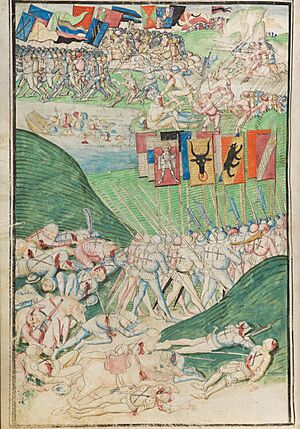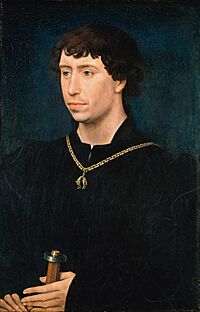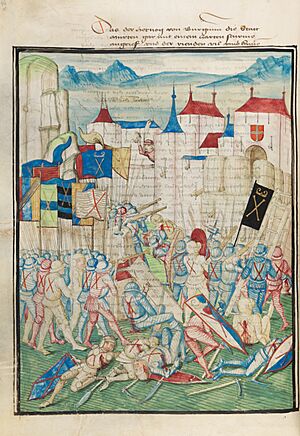Burgundian Wars facts for kids
Quick facts for kids Burgundian Wars |
|||||||||
|---|---|---|---|---|---|---|---|---|---|
 The battle of Morat, from Diebold Schilling's Berne Chronicle |
|||||||||
|
|||||||||
| Belligerents | |||||||||
| Commanders and leaders | |||||||||
|
|
|||||||||
The Burgundian Wars were a series of fights between 1474 and 1477. They involved the powerful Burgundian State and the brave soldiers of the Old Swiss Confederacy and their friends.
The war started in 1474. Charles the Bold, the Duke of Burgundy, was a very ambitious leader. But he lost three big battles in a row. He was finally killed in the Battle of Nancy in 1477.
After Charles's death, his lands were divided. Part of Burgundy became part of France. Other parts, like the Burgundian Netherlands, went to his daughter, Mary of Burgundy. Her marriage to Maximilian I, Holy Roman Emperor meant these lands eventually joined the House of Habsburg.
Why the War Started
For about 100 years, the dukes of Burgundy had become very strong. Their lands were located between the Holy Roman Empire and France. They brought together many different areas, which made their state rich and powerful.
Burgundy controlled important places like Flanders and Brabant. These areas were very good for trade and brought in a lot of money. This wealth helped the dukes fund their big plans.
The dukes of Burgundy wanted to expand their lands even more. They especially wanted to connect their northern and southern territories. This meant taking over areas like Alsace and Lorraine.
Charles the Bold often clashed with his neighbors. He had even sided with England during the Hundred Years' War. His expansion plans led him to conflict with the Habsburgs, led by Emperor Frederick III.
The Swiss also wanted to expand their lands and be free from Habsburg rule. They took control of the Habsburg town of Thurgau. Charles the Bold's soldiers also attacked people from Bern, a Swiss city. This made the Swiss very worried. They started calling Charles the Bold "the Turk in the West" because he was as much a threat as the Ottoman Empire in the East.
The Main Fights
In 1469, Duke Sigismund of Austria gave some of his lands in Alsace to Charles the Bold. He did this in exchange for money and an alliance. Sigismund hoped Charles would protect his lands from the growing Old Swiss Confederacy.
But Charles was more interested in his own expansion. His actions, like stopping trade with cities like Basel and Strasbourg, made them angry. These cities asked Bern for help.
Charles's plans hit a snag when his attack on the Archbishopric of Cologne failed. He couldn't capture the city of Neuss after a long siege from 1474 to 1475.
Meanwhile, Sigismund made peace with the Swiss in 1474. He wanted to buy back his lands from Charles, but Charles refused. Soon after, the Swiss, along with the Alsace cities and Sigismund, formed a group against Burgundy. They won the Battle of Héricourt in November 1474.
King Louis XI of France also joined this group in December. The next year, soldiers from Bern took over parts of Vaud. This area belonged to the Duchy of Savoy, which was allied with Charles the Bold. Bern wanted to expand and protect its borders.
However, other Swiss cities were not happy with Bern's aggressive actions. The Swiss Confederacy was meant for defense, not invasion. So, at first, they didn't help Bern in Savoy.
In the Valais region, local groups, with help from Bern, pushed out the Savoyards. They won the Battle on the Planta in November 1475.
In 1476, Charles the Bold fought back. He marched to Grandson, which the Swiss had recently taken. He had the captured soldiers executed. But when the Swiss army arrived, Charles was defeated in the Battle of Grandson. He had to run away, leaving behind his cannons and supplies.
Charles gathered his army again, but the Swiss dealt him another huge defeat at the Battle of Morat. As Charles kept losing, his own lords started to turn against him. A rebellion began, led by René II, Duke of Lorraine. René's lands were important for connecting Burgundy's northern and southern parts. He cut off Charles's supplies and communication.
This internal conflict made the war even harder for Charles. He had to deal with René's revolt while still fighting the Swiss. Charles the Bold raised a new army, but he was killed during the Battle of Nancy in 1477. The Swiss fought alongside René's army in this final battle.
A famous Swiss saying about Charles the Bold's defeats goes: "Charles the Bold lost his goods at Grandson, his bravery at Morat and his blood at Nancy."
Near the end of 1476, Pope Sixtus IV asked the Swiss to make peace with Charles. The Pope wanted Charles to focus on fighting Muslims instead. But the Swiss ignored the Pope. They refused to end the war unless Charles left the Duchy of Lorraine, which René II controlled.
Both sides used spies during the war. Spies gathered information about enemy movements and weak points. But it was a very dangerous job, and getting good information was always hard.
The Swiss victories also changed how wars were fought in Europe. The Swiss Gewalthaufen (a large block of pikemen) was very effective. Before this, cavalry (soldiers on horseback) usually won battles. But the Swiss used long spears to stop cavalry charges. This was a big change in military history. It showed that foot soldiers could be stronger than mounted soldiers.
What Happened Next
Charles the Bold's death had a huge impact on Burgundy and Europe. The Valois family line of Burgundian dukes ended. Many revolts broke out, and the Duchy of Burgundy fell apart.
The northern parts of Burgundy, like the Burgundian Netherlands, went to the Habsburg family. This happened when Archduke Maximilian of Austria married Charles's only daughter, Mary of Burgundy.
The main Duchy of Burgundy itself went back to the King of France, Louis XI. The Franche-Comté also became French at first. But it was later given to Maximilian's son, Philip, in 1493. This was part of a deal to keep the emperor neutral during France's plans to invade Italy.
The Swiss Confederation's victories made them seem almost unbeatable. The Burgundian Wars marked the beginning of Swiss mercenaries becoming famous across Europe. These skilled soldiers were hired by many armies.
Even though the Swiss won, there were some problems at home. The cities that supplied the most soldiers wanted most of the rewards. The country areas didn't like this. These disagreements almost led to another war among the Swiss themselves. But they were settled by an agreement called the Stanser Verkommnis in 1481.
See also
- Battles of the Burgundian Wars
- Cologne Diocesan Feud





